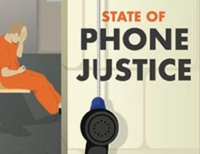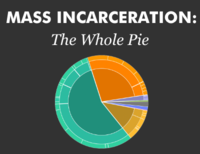Estimating the impact: How many people are excluded from Fair Housing protections because of a past drug conviction?
A little-known 1988 law called the Thurmond Amendment stripped people with drug distribution convictions of federal protections under the Fair Housing Act, making it even more difficult for many people with criminal records to secure housing - even when they are qualified in every other way, and even when the conviction is decades old. By our count, this law makes it more difficult for as many as 3 million people with these kinds of convictions to secure housing.
by Wendy Sawyer, February 5, 2025
You’ve probably never heard of the Thurmond Amendment, but for almost 40 years, it has been quietly enabling landlords to deny housing to people based solely on a past conviction for selling drugs — no matter how qualified they are as tenants, no matter what drugs or quantities were involved, and no matter how long ago they were convicted. This lifelong collateral consequence, tied to this one specific type of conviction, makes it even more difficult for people with criminal records to find housing at a time when it’s already a near-impossible task given the highly competitive rental markets in the U.S. As we and many other researchers have explained before, safe and stable housing is a critical factor in reentry success, while homelessness puts people directly in the crosshairs of law enforcement. These facts put the Thurmond Amendment directly at odds with correctional and public safety interests.
A coalition of advocates is working to repeal the law, led by a real estate investor who was directly impacted by the Thurmond Amendment. Their first step: gathering the available data about its impact and raising awareness of this overlooked relic of the failed “war on drugs.” That’s where we at the Prison Policy Initiative come in. One form of support we offer advocates — particularly through our Policy & Advocacy team — is to bring to light the relevant data that exists about an issue, and to find ways to fill in the gaps where the necessary information simply isn’t available. When the coalition came to us with the question of how many people are potentially impacted by the Thurmond Amendment, we combed through the available historical data to come up with an estimate, ultimately finding that over 3 million people in the U.S. have received drug distribution convictions since 1986 (which is as far back as the available data go).
Understanding the Fair Housing Act and the Thurmond Amendment
The Fair Housing Act of 1968, a key piece of civil rights legislation, declared discrimination by housing providers on the basis of race, religion, sex, national origin, familial status, or disability illegal. The 1988 Fair Housing Amendments Act strengthened the Department of Housing and Urban Development’s (HUD’s) power to enforce the Act, creating a new avenue of legal recourse for tenants and homebuyers who experience discrimination when applying to rent an apartment, buy a home, or take out a mortgage.
Enacted at the height of the failed “war on drugs,” however, the 1988 law includes an amendment named for its sponsor, the segregationist Strom Thurmond, which explicitly denies fair housing protections to people who have been convicted of drug manufacturing or distribution. While this amendment may seem like an odd thing to tack onto civil rights legislation that does not explicitly protect people from discrimination based on criminal history, it creates a carveout that allows landlords to deny housing to this specific population. Because drug distribution convictions — and criminal records more broadly — disproportionately impact Black and Brown people, discrimination against all individuals with criminal records is effectively a form of racial discrimination.6 On this basis, when housing providers discriminate against people with criminal records, individuals can make “discriminatory effect” claims under the Fair Housing Act. However, when landlords discriminate against people with drug distribution convictions specifically, the Thurmond Amendment makes these claims impossible. No other category of criminal conviction is excluded in the same way.
Importantly, repealing the Thurmond Amendment would do nothing to diminish the autonomy of landlords and other housing providers. The Fair Housing Act doesn’t require anyone to provide housing to people with drug distribution convictions, or any other kind of conviction for that matter. It just encourages them to consider applications more fully instead of automatically disqualifying people on the basis of a criminal record alone.
We know better now: Lessons learned about drugs, crime, and housing
The Thurmond Amendment was an expression of “tough on crime” 1980s politics, which were rationalized by false beliefs about drugs, crime, and punishment. For instance, in a recent op-ed, Yusef Dahl, who has been leading the effort to repeal the Amendment, points to the misconception that people who sell drugs are different from people who use drugs, which was central to how Thurmond sold the amendment to the rest of Congress: “drug dealers,” he argued, don’t deserve federal protection. In reality, distributors and users are often the same people: the most recent national data show that 78% of people in state prisons whose most serious offense was drug-related 7 reported using any drug in the month before their arrest. More than half (55%) were using at the time of the offense itself. 8 Among people sentenced to local jails for drug-related offenses (i.e., those serving shorter sentences than people in prison), the most recent data show 74% met the criteria for a substance use disorder. While it may be rhetorically convenient for politicians to vilify people who sell drugs, doing so necessarily casts a wide net around drug users who are often coping with poverty and illness.
Second, the Thurmond Amendment’s complete exclusion of people convicted of drug distribution, no matter how long ago, implies a belief that people don’t change.9 Decades of criminological research on desistance (the individual process of shifting away from lawbreaking behavior) prove otherwise. In fact, among the recommendations of experts Shawn Bushway and Christopher Uggen, authors of the chapter linked above, is “eliminat[ing] most collateral consequences of criminal justice involvement,” such as barriers to housing. Putting a finer point on it, they write: “Policies that continue to center a criminal act years after that act was committed directly contradict everything we know about desistance.”
Ultimately, this is the problem with the Thurmond Amendment: while it was added ostensibly so landlords could “protect other tenants,” it actually works directly against public safety interests. Securing safe, stable housing is one of the greatest challenges for people during reentry, and it makes a difference in reentry success, as previous research has shown. Creating additional barriers to housing for people with criminal records is simply bad policy.
To learn more about the effort to repeal the Thurmond Amendment, go to https://www.thurmondamendment.org.
Footnotes
-
Drug distribution/manufacturing charges are typically felonies, but some states classify certain distribution/manufacturing charges as misdemeanors, such as when they involve marijuana. The Thurmond Amendment also excludes people with these misdemeanor convictions from fair housing protections. ↩
-
For the years 2007-2023, for which our state court estimates are based on arrests for drug sale/manufacturing and the proportion of those arrests that result in felony convictions, we did not attempt to disentangle arrests that might have resulted in federal court convictions. However, we believe that this likely results in an undercount of felony convictions rather than double-counting, because arrests by the Drug Enforcement Agency (DEA) — the federal agency that makes the most drug arrests .— are not reported to the FBI’s Uniform Crime Reporting program (our source for arrest data). And because most DEA arrests result in federal rather than state prosecution, the resulting convictions are captured in the federal United States Sentencing Commission conviction data. ↩
-
This ratio has varied over the years; in 2004, 71 per 100 arrests for drug sale/manufacturing resulted in felony convictions, and in 1986 it was 41 per 100 arrests. ↩
-
The percentage of people convicted of drug “trafficking” who had prior convictions for the same offense increased fairly steadily over the years it was reported, from 27.3% in 2016 to 33.3% in 2023. Because of this linear trend, we considered using estimates based on the least squares regression line for those years, but ultimately decided that those estimates were likely to underestimate the number of people with prior convictions (for example, this method would predict just 5% of people convicted in 1990 had a prior conviction for the same offense). Instead, we opted to use the larger proportion which produced a more conservative final estimate of unique convictions for drug sale/manufacturing. ↩
-
For example, we excluded about half of all estimated state court convictions under the assumption that they could all be subsequent convictions for the same offense, even though the data we used to rationalize their exclusion was based on how many people arrested for drug sale/manufacturing had any prior felony conviction, not specifically drug distribution or manufacturing convictions. Given the relatively small proportion of drug sale/manufacturing convictions out of all state felony convictions reported from 1986 to 2009 (an average of 19%), and the fact that more people released from prison sentences for drug offenses are rearrested for non-drug charges than for drug charges, this choice almost certainly excluded many people who did not have a prior conviction for drug sale/manufacturing. Furthermore, our estimates do not include people who have only a misdemeanor-level drug distribution/manufacturing conviction, even though these convictions also bar people from federal fair housing protections under the Thurmond Amendment. ↩
-
This is known as the “discriminatory effects rule,” which the Department of Housing and Urban Development (HUD) explains in this helpful Fact Sheet: “The Fair Housing Act bars more than intentionally discriminatory conduct — it also bars policies that have an unjustified discriminatory effect based on race, national origin, disability, or other protected class. As an example, a landlord’s policy of excluding people who have any criminal record… often will have a discriminatory effect based on race, national origin, and disability.” While these policies are not always unlawful, as HUD points out, “a policy that ha[s] a discriminatory effect on a protected class [is] unlawful if it [is] not necessary to achieve a substantial, legitimate, nondiscriminatory interest or if a less discriminatory alternative could also serve that interest.” ↩
-
Most of these people (72%) were in prison for drug trafficking (manufacturing or distribution) as opposed to possession (25%) or other drug offenses (3%). See Table 3 in the Bureau of Justice Statistics report Profile of Prison Inmates, 2016. ↩
-
These percentages were also high, if less dramatically so, among people in federal prisons whose most serious offense was drug-related: 61% reported using any drug in the month before the arrest that led to their incarceration, and 38% reported using at the time of the offense. See tables 4 and 5 in the Bureau of Justice Statistics report Alcohol and Drug Use and Treatment Reported by Prisoners: Survey of Prison Inmates, 2016. ↩
-
On this point it is worth noting that before Sen. Thurmond introduced his amendment, the bill already included language allowing discrimination against people “convicted two or more times … of illegal manufacture or distribution of a controlled substance” (emphasis added). In his rationale for that amendment, Rep. Bob Walker noted that, on the question of whether people who used drugs would be protected under the law, an earlier committee report had made clear that the intent was that “somebody who has cleaned up their act” would not be excluded from protections but that “we are not going to allow current users to have the protection.” Walker saw his amendment (excluding “dealers” with two or more convictions) as an extension of that logic, suggesting that he and other members of Congress — unlike Thurmond — recognized that people change and that they should not be treated differently under the law if they were not “currently engaged” in drug distribution (emphasis added). ↩




